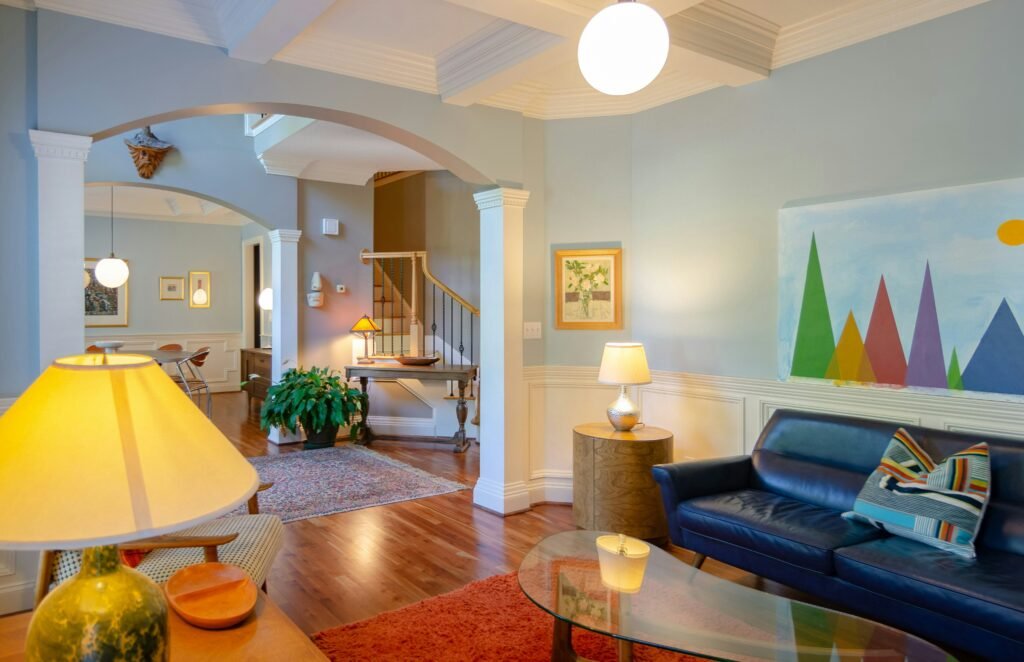Lighting Design in Home Staging & Interior Design:
The strategic use of different light sources and fixtures to create layers of illumination, enhance architectural features, and set the moodTheme in Home Staging & Interior Design: A unifying concept or inspiration for a staged space, influencing décor choices, color palettes, and overall ambience. The Importance of Theme in Home Staging - Why it's Something to Consider A Theme in home staging helps to create a cohesive look and fe... in a space.

The Importance of Lighting Design in Home Staging – Why it’s Something to Consider
Lighting Design is a critical element in home staging as it can significantly influence the ambiance and perceptionStaging Psychology in Home Staging & Interior Design: Understanding the psychological impact of space on potential buyers and utilizing staging techniques to evoke positive emotions. The Importance of Staging Psychology in Home Staging - Why it's Something to Consider Staging Psychology involves... of a space. Proper lighting can highlight the best features of a home, create a mood, and make spaces feel more open and inviting. It involves a mix of ambient, task, and accent lighting"Accent Lighting" in Home Staging & Interior Design: Intentional spotlights or lamps used to highlight specific features, artwork, or architectural elements, adding depth and visual interest to a space. The Importance of Accent Lighting in Home Staging - Why it's Something to Consider Accent Lig... to enhance the functionalityFunctionality in Home Staging & Interior Design: The ability of a space to serve its intended purpose efficiently and comfortably. Staging considers furniture function, traffic flow, and accessibility to optimize everyday living. The Importance of Functionality in Home Staging - Why it's Somethi... and aesthetic"Aesthetic" in Home Staging & Interior Design: The overall feeling or vibe of a space, encompassing the chosen style, color palette, textures, and furniture, and evoking a specific mood or impression. The Importance of Aesthetic In Home Staging - Why It's Something to Consider Aesthetic, encompa... appeal"Appeal" in Home Staging & Interior Design: The overall attractiveness and desirability of a property to potential buyers, influenced by factors like curb appeal, layout, functionality, and staging. The Importance of Appeal In Home Staging - Why It's Something to Consider Appeal, in the context ... of each room.
When considering lighting design in home staging, it’s important to ensure that each space is well-lit and that the lighting complements the room’s purpose and styleStyle in Home Staging & Interior Design: The overall aesthetic or design language chosen for a space, influencing furniture selection, décor, color palette, and textures. The Importance of Style in Home Staging - Why it's Something to Consider The Style chosen in home staging sets the overall t.... This can involve using brighter lights in kitchens and bathrooms for functionality, softer lighting in bedrooms for a relaxing atmosphere, and accent lighting to highlight art or architectural features. Effective lighting design can transform the look and feel of a home, making it more appealing to potential buyers.
Tips and Best Practices when Utilizing Lighting Design in Home Staging
Lighting Design is crucial in creating the right atmosphere and showcasing the property’s best features. Best practices include:
Layer Lighting: Combine ambient, task, and accent lighting to create depthLayering in Home Staging & Interior Design: Combining various elements like textures, patterns, and colors in a space to add depth, visual interest, and a sense of coziness. Layering is a key technique in creating inviting and stylish spaces. The Importance of Layering in Home Staging - Why it's... and interest in each room.
Highlight Architectural Features: Use lighting to emphasize architectural details such as fireplaces, artwork, or unique wall texturesMateriality in Home Staging & Interior Design: The selection and combination of materials used in a space, like wood, metal, glass, fabric, and stone. In staging and design, it influences the overall aesthetic, texture, and tactile experience, impacting the mood and functionality of the space. T....
Appropriate Fixture Selection: Choose light fixtures that complement the style"Accessorizing" in Home Staging & Interior Design: The act of adding decorative elements to a space, like placing throw pillows on a sofa or arranging books on a coffee table, to complete the look and inject personality. The Importance of Accessorizing In Home Staging - Why It's Something to Con... of the home and the staging decor.
Maximize Natural Light: Enhance natural light wherever possible through window treatments and mirror placement.
Create a Welcoming Atmosphere: Use warm lighting in living areas and bedrooms to create a cozy, inviting atmosphere.

